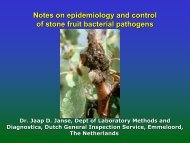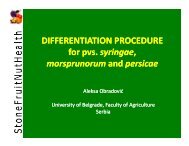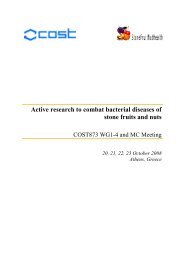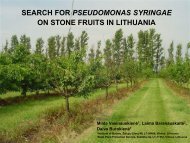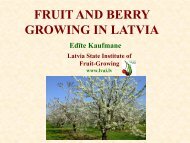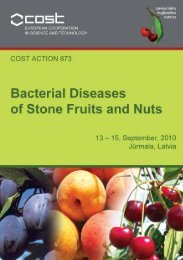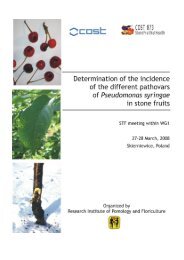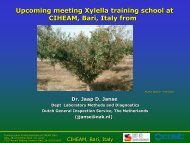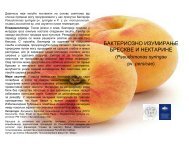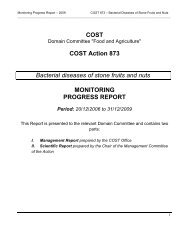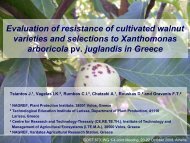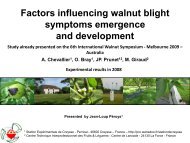ARTICLE IN PRESSJ. Pu"awska et al. / Systematic <strong>and</strong> Applied Microbiology 29 (2006) 470–479 475SDS-PAGE <strong>of</strong> whole-cell proteinsWhole-cell protein extracts were prepared <strong>and</strong> separatedby electrophoresis using slight modifications <strong>of</strong> theprocedure <strong>of</strong> Laemmli [16] as described by de Lajudieet al. [4].Results <strong>and</strong> discussionPresented study allowed to develop a rapid methodfor <strong>identification</strong> <strong>and</strong> differentiation <strong>of</strong> 4 taxa belongingto genus <strong>Agrobacterium</strong> using multiplex PCR withprimers complementary to the 23S rRNA gene. Up tonow, analysis <strong>of</strong> phenotypic features based on biochemicaltests has been the phytopathologist’s st<strong>and</strong>ardmethod to classify agrobacteria into biovar 1, biovar2, A. vitis <strong>and</strong> A. rubi [18]. However, unambiguousclassification <strong>of</strong> agrobacteria into a particular taxon islaborious <strong>and</strong> time-consuming, <strong>and</strong> the results are very<strong>of</strong>ten difficult to interpret. Modern systems <strong>of</strong> bacterial<strong>identification</strong> exploit techniques based on analysis <strong>of</strong>sequences <strong>of</strong> functional genes. One <strong>of</strong> the most <strong>of</strong>tenused for this purpose is the gene coding for 16S rRNA.Systems based on this gene were developed for rapid<strong>identification</strong> <strong>of</strong> bacteria belonging to genera Bifidobacterium[6], Mycobacterium, Nocardia <strong>and</strong> others (reviewedin [15]). However, among agrobacteria thedivergence in sequences <strong>of</strong> 16S rDNA is not highenough for this system to be effective. For example,dissimilarity between 16S rDNA sequences <strong>of</strong> A. rubi<strong>and</strong> <strong>Agrobacterium</strong> biovar 1 is only 1.5%, which limitsthe possibilities for developing primers or probesdifferentiating these 2 taxa [26,33]. Mougel et al. [19]designed probes complementary to 16S rDNA, whichallow the discrimination <strong>of</strong> biovar 2, but not biovar 1agrobacteria <strong>and</strong> A. rubi. The gene coding for 23SrRNA contains more information than that for 16SrRNA <strong>and</strong> has already been used for <strong>identification</strong> <strong>of</strong>bacteria <strong>of</strong> other genera [17,30]. In the case <strong>of</strong><strong>Agrobacterium</strong>, higher dissimilarity between sequences<strong>of</strong> all species/biovars was found for this gene. Forinstance, differences between 23S rDNA sequences <strong>of</strong>biovar 1 agrobacteria <strong>and</strong> A. rubi ranged from 2.37% to3.09% [23], <strong>of</strong>fering more scope for the development <strong>of</strong><strong>specific</strong> primers. Similar results were obtained also byPeplies et al. [20], who in study on oligonucleotide probedesign for some marine Alphaproteobacteria found that23S rRNA gene has up to 8 times more discriminatorysites than 16S rRNA.Based on BLAST N analysis, 4 <strong>of</strong> the developedprimers, UF, B2R, AvR <strong>and</strong> ArR showed 100%homology only to the 23S rDNA sequences <strong>of</strong> the taxathey were designed to identify. The sequence <strong>of</strong> primerB1R, in addition to homology to 23S rDNA sequence <strong>of</strong><strong>Agrobacterium</strong> biovar 1, also showed 100% homologyto gene sequences <strong>of</strong> A. rubi IAM 13569 (AY244376)<strong>and</strong> A. vitis IAM 14140 (AY244374). However, thesesequences may be misnamed, because on the basis <strong>of</strong>cluster analysis <strong>of</strong> all known 23S rDNA sequences <strong>of</strong>bacteria belonging to family Rhizobiaceae they are mostsimilar to sequences <strong>of</strong> biovar 1 strains <strong>of</strong> <strong>Agrobacterium</strong>,but not to other sequences <strong>of</strong> A. rubi (AF205373)<strong>and</strong> A. vitis (AF209071, AF209076, AY244370) strains(including the type strains) present in the publicdatabases.The <strong>specific</strong>ity <strong>of</strong> the newly developed primers wastested in PCRs using DNA <strong>of</strong> 119 bacterial strainsincluding: 93 <strong>of</strong> <strong>Agrobacterium</strong>, 19 <strong>of</strong> rhizobia <strong>and</strong> 7strains <strong>of</strong> phytopathogenic bacteria representing variousgenera. Primers developed for <strong>identification</strong> <strong>of</strong> bacteriaclassified as A. vitis, A. rubi <strong>and</strong> <strong>Agrobacterium</strong> biovar 1,amplified DNA <strong>of</strong> strains belonging only to these taxa<strong>and</strong> gave products <strong>of</strong> the expected sizes: 478, 1006 <strong>and</strong>184 bp, respectively. However, primer B2R, combinedwith primer UF, in addition to strains <strong>of</strong> <strong>Agrobacterium</strong>biovar 2, also amplified DNA <strong>of</strong> some (though not all)strains <strong>of</strong> other, closely related genera such as:Allorhizobium undicola, Rhizobium etli, R. leguminosarumbv. trifolii, R. tropici <strong>and</strong> all tested strains <strong>of</strong> thegenus Sinorhizobium. None <strong>of</strong> tested primers amplifiedDNA <strong>of</strong> strains belonging to A. larrymoorei, Phyllobacterium,Arthrobacter, Erwinia, Pseudomonas or Xanthomonas(Table 1). The results obtained in separate PCRswith following sets <strong>of</strong> primers: UF+B1R, UF+B2R,UF+AvR <strong>and</strong> UF+ArR were identical with thoseobtained in the PCRs, using all 5 primers simultaneously.Four PCR products <strong>of</strong> expected sizes wereobtained as a result <strong>of</strong> multiplex PCR with DNAmixture <strong>of</strong> representative strains <strong>of</strong> all <strong>Agrobacterium</strong>taxa (Fig. 1).As a result <strong>of</strong> DNA amplification with primers UF<strong>and</strong> B2R, a characteristic product <strong>of</strong> 1066 bp wasobtained in PCRs with DNA <strong>of</strong> 3 strains <strong>of</strong> <strong>Agrobacterium</strong>biovar 1, 58 strains <strong>of</strong> biovar 2 <strong>and</strong> 10 rhizobiastrains (Table 1). Restriction analysis <strong>of</strong> these productsusing endonuclease Alw26I allowed differentiation <strong>of</strong>biovar 2 strains from the other strains. The followingDNA fragments were obtained after digestion <strong>of</strong> the1066 bp PCR product <strong>of</strong> agrobacteria belonging tobiovar 2: 1006 <strong>and</strong> 60 bp, whereas in case <strong>of</strong> the otherbacteria 3 products (830, 167 <strong>and</strong> 60 bp, as expected onthe basis <strong>of</strong> computer analysis) were obtained (Table 1,Fig. 2).In case <strong>of</strong> strain 47/7, a 184 bp product typical forbiovar 1 was obtained as a result <strong>of</strong> amplification withprimers UF+B1R. However, this strain could not beclearly classified in biovar 1 on the basis <strong>of</strong> phenotypicfeatures. It showed typical features for biovar 2, such asthe ability to produce an acid from erythritol <strong>and</strong> it was3-ketolactose negative but at the same time showed
476ARTICLE IN PRESSJ. Pu"awska et al. / Systematic <strong>and</strong> Applied Microbiology 29 (2006) 470–479M 1 2 3 4 5 6 7 8 9 10 11 12 13M 1 2 3 4 5 6 7 8 9500 bp→Fig. 1. Electrophoresis gel showing PCR products obtained inmultiplex PCR with DNA <strong>of</strong> following <strong>Agrobacterium</strong> strains:1 – B6 (bv 1); 2 – LMG 150 (bv 2); 3 – LMG 8750 (A. vitis);4–LMG 156 (A. rubi); 5 – LMG 21410 (A. larrymoorei); 6 –mixture <strong>of</strong> DNA <strong>of</strong> strains B6, LMG 150, LMG 8750, LMG156 <strong>and</strong> LMG 21410; 7 – 47/7; 8 – 0; 9 – 7/1; 10 – 39/7; 11 –Ch11; 12 – Ch12; 13 – negative control; M – molecular weightmarker 100 bp ladder (Fermentas, Lithuania).500 bp→features typical for biovar 1 such as presence <strong>of</strong> oxidaseC as well as growth <strong>and</strong> pigmentation in ferricammonium citrate broth (Table 2). We verified its 16SrDNA sequence <strong>and</strong> found that 47/7 was 100% similarto that <strong>of</strong> <strong>Agrobacterium</strong> biovar 1 strain IAM 13129(accession no. D12784) <strong>and</strong> thus we can conclude it isindeed a biovar 1 strain (data unpublished).DNA <strong>of</strong> 3 other Hungarian strains (0, 7/1, 39/7) wasamplified both with primers complementary to 23SrDNA sequence <strong>of</strong> <strong>Agrobacterium</strong> biovar 1 <strong>and</strong> biovar2. As a result <strong>of</strong> amplification with the 5-primer mixture2 PCR products (184 <strong>and</strong> 1066 bp) were obtained(Fig. 1). Analysis <strong>of</strong> phenotypic features showed, thatthese 3 strains were most similar to biovar 1, except intheir ability to grow <strong>and</strong> produce pigment in ferricammonium citrate broth (Table 2). On the other h<strong>and</strong>,restriction analysis with Alw26I <strong>of</strong> products obtainedwith primers UF+B2R gave the same 3 fragments (830,167 <strong>and</strong> 60 bp) as those found for rhizobial strains butnot the 2 fragments (1006 <strong>and</strong> 60 bp) characteristic forbiovar 2. SDS-PAGE <strong>of</strong> total cellular proteins was usedas a rapid tool to screen for overall similarities <strong>of</strong> theHungarian strains <strong>and</strong> other taxa in our protein pr<strong>of</strong>iledatabase. It was found that these 3 strains producedsimilar protein patterns distinct from type strains <strong>of</strong>other biovars <strong>and</strong> species, but most similar to biovar 1strains (Fig. 3). They may represent a separate, hithertounrecognized taxon. The fact that none <strong>of</strong> the rhizobialstrains produced a product with the primer combinationUF+B1R as the Hungarian strains did, seems toconfirm that they may be a distinct group.Fig. 2. Restriction analysis with endonuclease Alw26I <strong>of</strong> PCRproducts obtained with primers UF+B2R. For comparisonnot digested product on lane 5 (1066 bp). Digestion fragments<strong>of</strong> UF+B2R PCR product <strong>of</strong> rhizobia (expected sizes: 830,167 <strong>and</strong> 60 bp): lane 1 – S. saheli LMG 7837; lane 2 – S.teranga LMG 7834; lane 3 – R. tropici LMG 9503; lane 4 – A.undicola LMG 11875. Digestion fragments <strong>of</strong> UF+B2R PCRproduct <strong>of</strong> some strains <strong>of</strong> agrobacteria biovar 2 (expectedsizes: 1006 <strong>and</strong> 60 bp): lane 6 – 39; lane 7 – LMG 150; lane 8 –K84; lane 9 – 129; lane 10 – 89. M – molecular weight marker100 bp ladder (Promega, USA).DNA <strong>of</strong> 2 <strong>Agrobacterium</strong> strains (Ch11 <strong>and</strong> Ch12)isolated from galls on chrysanthemum plants was notamplified with any set <strong>of</strong> primers, which suggests thatthey do not belong to any <strong>of</strong> the present biovars orspecies <strong>of</strong> <strong>Agrobacterium</strong>. Phenotypic characteristicsindicated that these strains are most similar to the A.rubi-type strain (Table 2), but FAME <strong>and</strong> RAPDanalysis did not confirm unambiguously their affinityto A. rubi [21]. Further studies should determine theirtaxonomic status.The method presented here is the first PCR-basedprotocol developed for <strong>identification</strong> <strong>and</strong> differentiation<strong>of</strong> bacteria belonging to biovars 1 <strong>and</strong> 2 <strong>of</strong> <strong>Agrobacterium</strong>,A. vitis <strong>and</strong> A. rubi. However, for discriminationbetween strains <strong>of</strong> biovar 2 <strong>and</strong> some rhizobia species




